engine coolant FIAT DOBLO COMBI 2017 2.G Owners Manual
[x] Cancel search | Manufacturer: FIAT, Model Year: 2017, Model line: DOBLO COMBI, Model: FIAT DOBLO COMBI 2017 2.GPages: 300, PDF Size: 24.91 MB
Page 51 of 300
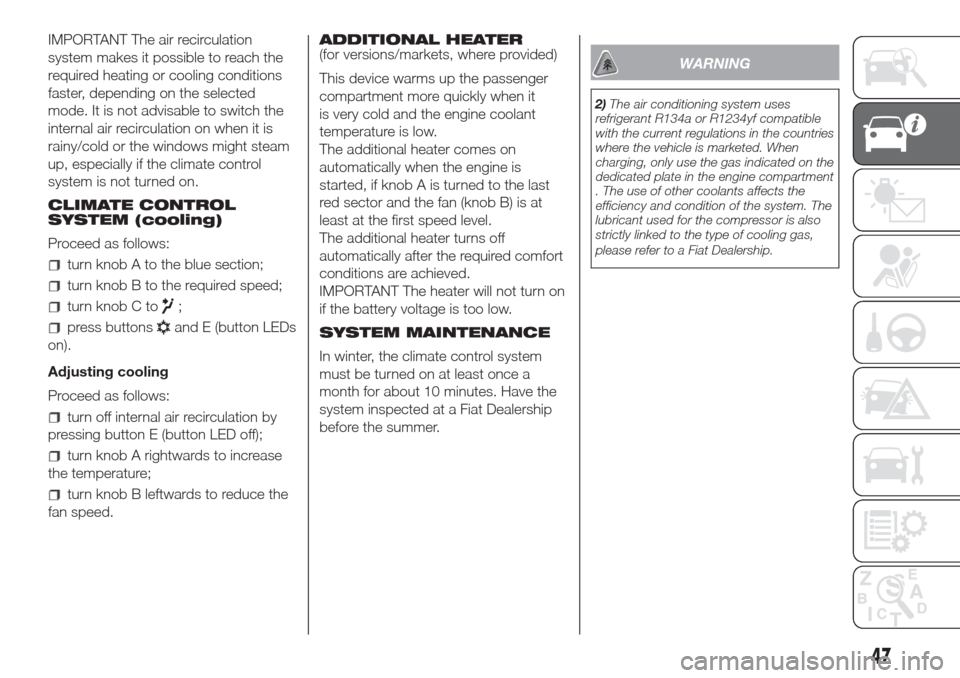
IMPORTANT The air recirculation
system makes it possible to reach the
required heating or cooling conditions
faster, depending on the selected
mode. It is not advisable to switch the
internal air recirculation on when it is
rainy/cold or the windows might steam
up, especially if the climate control
system is not turned on.
CLIMATE CONTROL
SYSTEM (cooling)
Proceed as follows:
turn knob A to the blue section;
turn knob B to the required speed;
turn knob C to;
press buttonsand E (button LEDs
on).
Adjusting cooling
Proceed as follows:
turn off internal air recirculation by
pressing button E (button LED off);
turn knob A rightwards to increase
the temperature;
turn knob B leftwards to reduce the
fan speed.ADDITIONAL HEATER
(for versions/markets, where provided)
This device warms up the passenger
compartment more quickly when it
is very cold and the engine coolant
temperature is low.
The additional heater comes on
automatically when the engine is
started, if knob A is turned to the last
red sector and the fan (knob B) is at
least at the first speed level.
The additional heater turns off
automatically after the required comfort
conditions are achieved.
IMPORTANT The heater will not turn on
if the battery voltage is too low.
SYSTEM MAINTENANCE
In winter, the climate control system
must be turned on at least once a
month for about 10 minutes. Have the
system inspected at a Fiat Dealership
before the summer.
WARNING
2)The air conditioning system uses
refrigerant R134a or R1234yf compatible
with the current regulations in the countries
where the vehicle is marketed. When
charging, only use the gas indicated on the
dedicated plate in the engine compartment
. The use of other coolants affects the
efficiency and condition of the system. The
lubricant used for the compressor is also
strictly linked to the type of cooling gas,
please refer to a Fiat Dealership.
47
Page 56 of 300
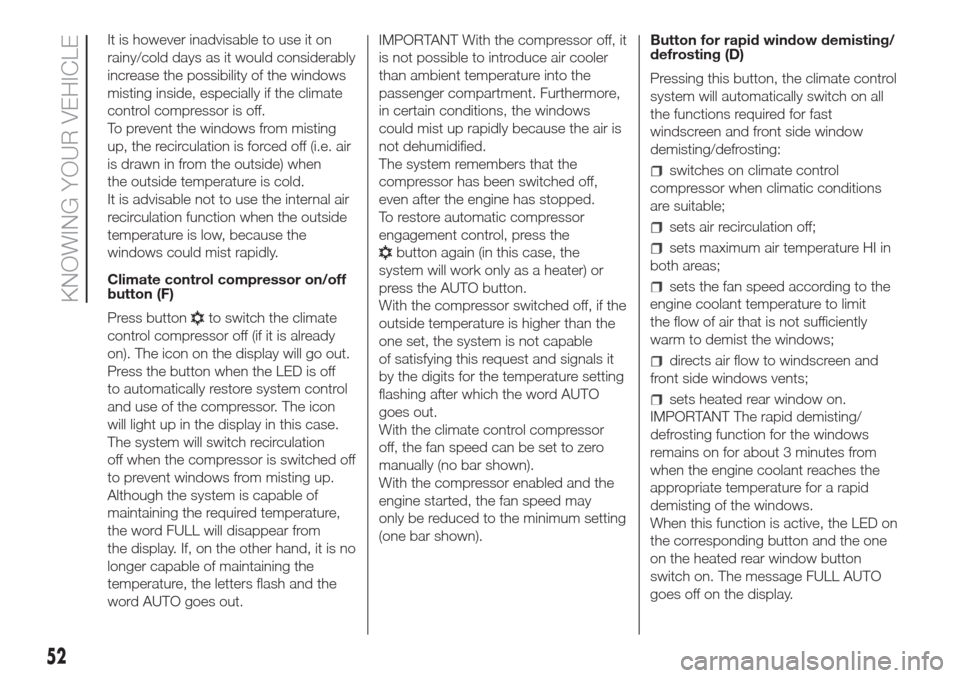
It is however inadvisable to use it on
rainy/cold days as it would considerably
increase the possibility of the windows
misting inside, especially if the climate
control compressor is off.
To prevent the windows from misting
up, the recirculation is forced off (i.e. air
is drawn in from the outside) when
the outside temperature is cold.
It is advisable not to use the internal air
recirculation function when the outside
temperature is low, because the
windows could mist rapidly.
Climate control compressor on/off
button (F)
Press button
to switch the climate
control compressor off (if it is already
on). The icon on the display will go out.
Press the button when the LED is off
to automatically restore system control
and use of the compressor. The icon
will light up in the display in this case.
The system will switch recirculation
off when the compressor is switched off
to prevent windows from misting up.
Although the system is capable of
maintaining the required temperature,
the word FULL will disappear from
the display. If, on the other hand, it is no
longer capable of maintaining the
temperature, the letters flash and the
word AUTO goes out.IMPORTANT With the compressor off, it
is not possible to introduce air cooler
than ambient temperature into the
passenger compartment. Furthermore,
in certain conditions, the windows
could mist up rapidly because the air is
not dehumidified.
The system remembers that the
compressor has been switched off,
even after the engine has stopped.
To restore automatic compressor
engagement control, press the
button again (in this case, the
system will work only as a heater) or
press the AUTO button.
With the compressor switched off, if the
outside temperature is higher than the
one set, the system is not capable
of satisfying this request and signals it
by the digits for the temperature setting
flashing after which the word AUTO
goes out.
With the climate control compressor
off, the fan speed can be set to zero
manually (no bar shown).
With the compressor enabled and the
engine started, the fan speed may
only be reduced to the minimum setting
(one bar shown).Button for rapid window demisting/
defrosting (D)
Pressing this button, the climate control
system will automatically switch on all
the functions required for fast
windscreen and front side window
demisting/defrosting:
switches on climate control
compressor when climatic conditions
are suitable;
sets air recirculation off;
sets maximum air temperature HI in
both areas;
sets the fan speed according to the
engine coolant temperature to limit
the flow of air that is not sufficiently
warm to demist the windows;
directs air flow to windscreen and
front side windows vents;
sets heated rear window on.
IMPORTANT The rapid demisting/
defrosting function for the windows
remains on for about 3 minutes from
when the engine coolant reaches the
appropriate temperature for a rapid
demisting of the windows.
When this function is active, the LED on
the corresponding button and the one
on the heated rear window button
switch on. The message FULL AUTO
goes off on the display.
52
KNOWING YOUR VEHICLE
Page 57 of 300
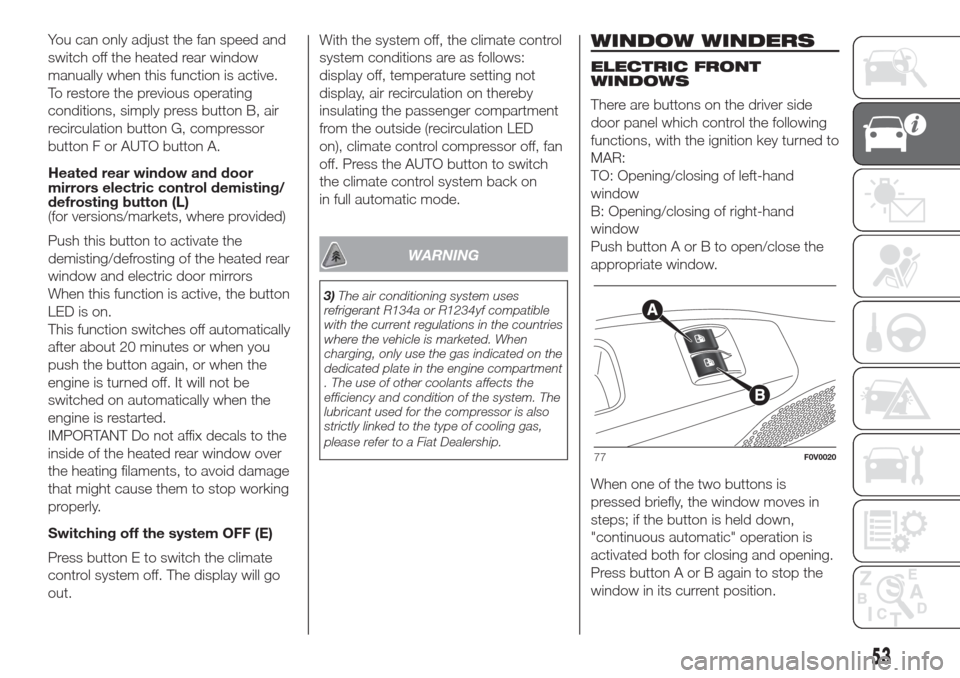
You can only adjust the fan speed and
switch off the heated rear window
manually when this function is active.
To restore the previous operating
conditions, simply press button B, air
recirculation button G, compressor
button F or AUTO button A.
Heated rear window and door
mirrors electric control demisting/
defrosting button (L)
(for versions/markets, where provided)
Push this button to activate the
demisting/defrosting of the heated rear
window and electric door mirrors
When this function is active, the button
LED is on.
This function switches off automatically
after about 20 minutes or when you
push the button again, or when the
engine is turned off. It will not be
switched on automatically when the
engine is restarted.
IMPORTANT Do not affix decals to the
inside of the heated rear window over
the heating filaments, to avoid damage
that might cause them to stop working
properly.
Switching off the system OFF (E)
Press button E to switch the climate
control system off. The display will go
out.With the system off, the climate control
system conditions are as follows:
display off, temperature setting not
display, air recirculation on thereby
insulating the passenger compartment
from the outside (recirculation LED
on), climate control compressor off, fan
off. Press the AUTO button to switch
the climate control system back on
in full automatic mode.
WARNING
3)The air conditioning system uses
refrigerant R134a or R1234yf compatible
with the current regulations in the countries
where the vehicle is marketed. When
charging, only use the gas indicated on the
dedicated plate in the engine compartment
. The use of other coolants affects the
efficiency and condition of the system. The
lubricant used for the compressor is also
strictly linked to the type of cooling gas,
please refer to a Fiat Dealership.
WINDOW WINDERS
ELECTRIC FRONT
WINDOWS
There are buttons on the driver side
door panel which control the following
functions, with the ignition key turned to
MAR:
TO: Opening/closing of left-hand
window
B: Opening/closing of right-hand
window
Push button A or B to open/close the
appropriate window.
When one of the two buttons is
pressed briefly, the window moves in
steps; if the button is held down,
"continuous automatic" operation is
activated both for closing and opening.
Press button A or B again to stop the
window in its current position.
77F0V0020
53
Page 71 of 300
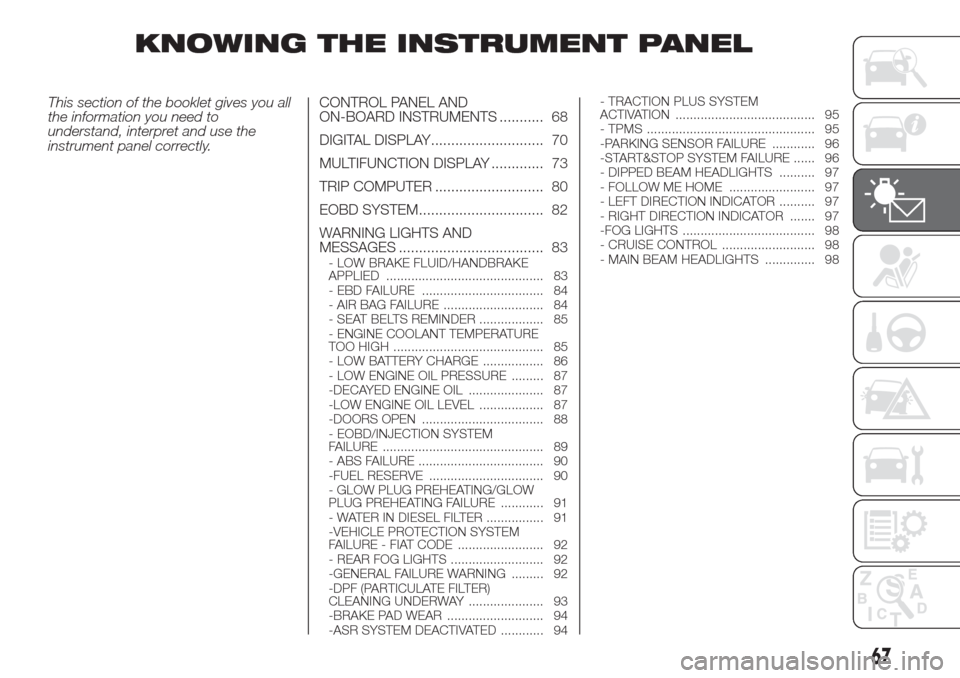
KNOWING THE INSTRUMENT PANEL
This section of the booklet gives you all
the information you need to
understand, interpret and use the
instrument panel correctly.CONTROL PANEL AND
ON-BOARD INSTRUMENTS ........... 68
DIGITAL DISPLAY............................ 70
MULTIFUNCTION DISPLAY ............. 73
TRIP COMPUTER ........................... 80
EOBD SYSTEM............................... 82
WARNING LIGHTS AND
MESSAGES .................................... 83
- LOW BRAKE FLUID/HANDBRAKE
APPLIED ............................................ 83
- EBD FAILURE .................................. 84
- AIR BAG FAILURE ............................ 84
- SEAT BELTS REMINDER .................. 85
- ENGINE COOLANT TEMPERATURE
TOO HIGH .......................................... 85
- LOW BATTERY CHARGE ................. 86
- LOW ENGINE OIL PRESSURE ......... 87
-DECAYED ENGINE OIL ..................... 87
-LOW ENGINE OIL LEVEL .................. 87
-DOORS OPEN .................................. 88
- EOBD/INJECTION SYSTEM
FAILURE ............................................. 89
- ABS FAILURE ................................... 90
-FUEL RESERVE ................................ 90
- GLOW PLUG PREHEATING/GLOW
PLUG PREHEATING FAILURE ............ 91
- WATER IN DIESEL FILTER ................ 91
-VEHICLE PROTECTION SYSTEM
FAILURE - FIAT CODE ........................ 92
- REAR FOG LIGHTS .......................... 92
-GENERAL FAILURE WARNING ......... 92
-DPF (PARTICULATE FILTER)
CLEANING UNDERWAY ..................... 93
-BRAKE PAD WEAR ........................... 94
-ASR SYSTEM DEACTIVATED ............ 94- TRACTION PLUS SYSTEM
ACTIVATION ....................................... 95
- TPMS ............................................... 95
-PARKING SENSOR FAILURE ............ 96
-START&STOP SYSTEM FAILURE ...... 96
- DIPPED BEAM HEADLIGHTS .......... 97
- FOLLOW ME HOME ........................ 97
- LEFT DIRECTION INDICATOR .......... 97
- RIGHT DIRECTION INDICATOR ....... 97
-FOG LIGHTS ..................................... 98
- CRUISE CONTROL .......................... 98
- MAIN BEAM HEADLIGHTS .............. 98
67
Page 72 of 300
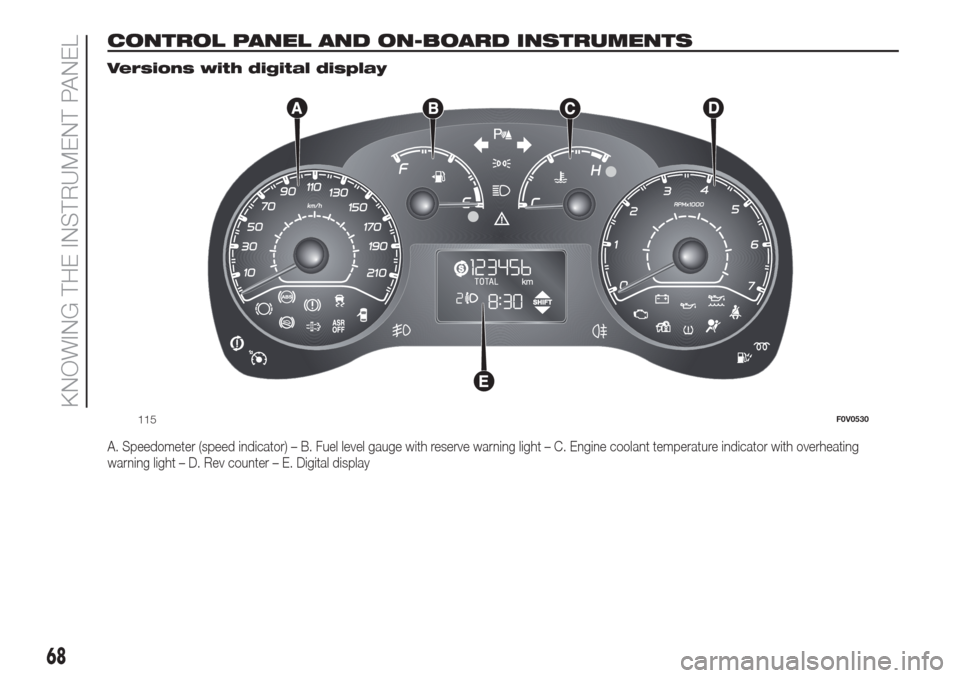
CONTROL PANEL AND ON-BOARD INSTRUMENTS.
Versions with digital display
A. Speedometer (speed indicator) – B. Fuel level gauge with reserve warning light – C. Engine coolant temperature indicator with overheating
warning light – D. Rev counter – E. Digital display
115F0V0530
68
KNOWING THE INSTRUMENT PANEL
Page 73 of 300
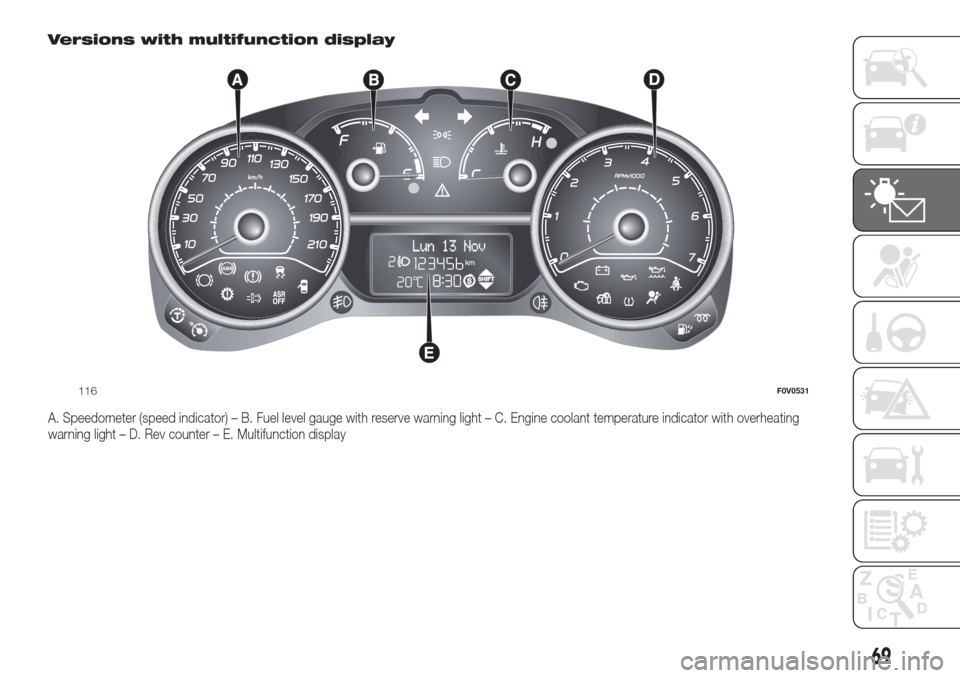
Versions with multifunction display
A. Speedometer (speed indicator) – B. Fuel level gauge with reserve warning light – C. Engine coolant temperature indicator with overheating
warning light – D. Rev counter – E. Multifunction display
116F0V0531
69
Page 74 of 300
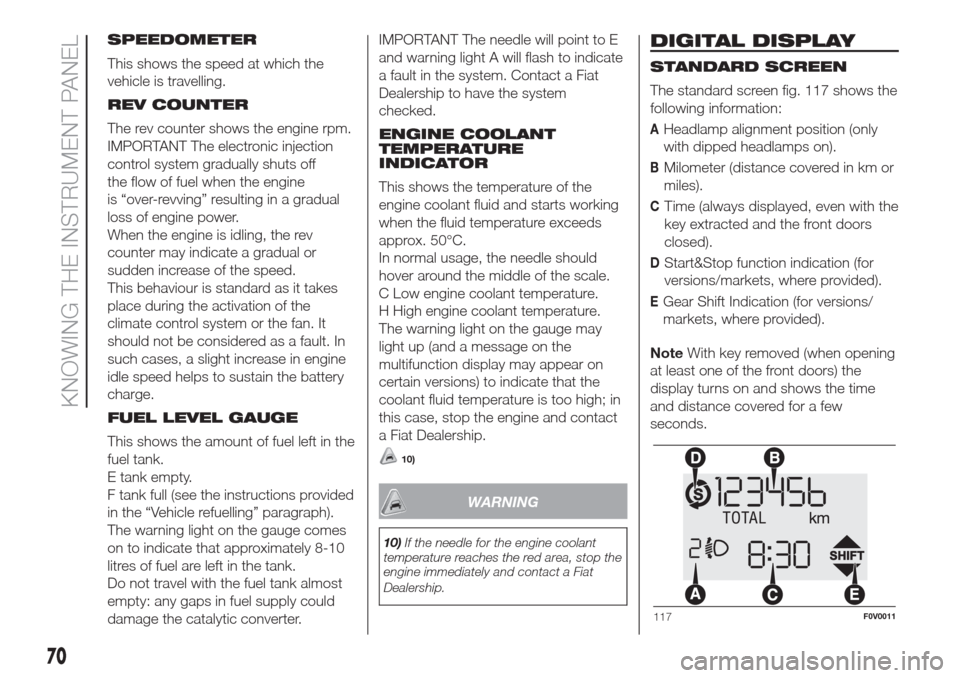
SPEEDOMETER
This shows the speed at which the
vehicle is travelling.
REV COUNTER
The rev counter shows the engine rpm.
IMPORTANT The electronic injection
control system gradually shuts off
the flow of fuel when the engine
is “over-revving” resulting in a gradual
loss of engine power.
When the engine is idling, the rev
counter may indicate a gradual or
sudden increase of the speed.
This behaviour is standard as it takes
place during the activation of the
climate control system or the fan. It
should not be considered as a fault. In
such cases, a slight increase in engine
idle speed helps to sustain the battery
charge.
FUEL LEVEL GAUGE
This shows the amount of fuel left in the
fuel tank.
E tank empty.
F tank full (see the instructions provided
in the “Vehicle refuelling” paragraph).
The warning light on the gauge comes
on to indicate that approximately 8-10
litres of fuel are left in the tank.
Do not travel with the fuel tank almost
empty: any gaps in fuel supply could
damage the catalytic converter.IMPORTANT The needle will point to E
and warning light A will flash to indicate
a fault in the system. Contact a Fiat
Dealership to have the system
checked.
ENGINE COOLANT
TEMPERATURE
INDICATOR
This shows the temperature of the
engine coolant fluid and starts working
when the fluid temperature exceeds
approx. 50°C.
In normal usage, the needle should
hover around the middle of the scale.
C Low engine coolant temperature.
H High engine coolant temperature.
The warning light on the gauge may
light up (and a message on the
multifunction display may appear on
certain versions) to indicate that the
coolant fluid temperature is too high; in
this case, stop the engine and contact
a Fiat Dealership.
10)
WARNING
10)If the needle for the engine coolant
temperature reaches the red area, stop the
engine immediately and contact a Fiat
Dealership.
DIGITAL DISPLAY
STANDARD SCREEN
The standard screen fig. 117 shows the
following information:
AHeadlamp alignment position (only
with dipped headlamps on).
BMilometer (distance covered in km or
miles).
CTime (always displayed, even with the
key extracted and the front doors
closed).
DStart&Stop function indication (for
versions/markets, where provided).
EGear Shift Indication (for versions/
markets, where provided).
NoteWith key removed (when opening
at least one of the front doors) the
display turns on and shows the time
and distance covered for a few
seconds.
117F0V0011
70
KNOWING THE INSTRUMENT PANEL
Page 89 of 300
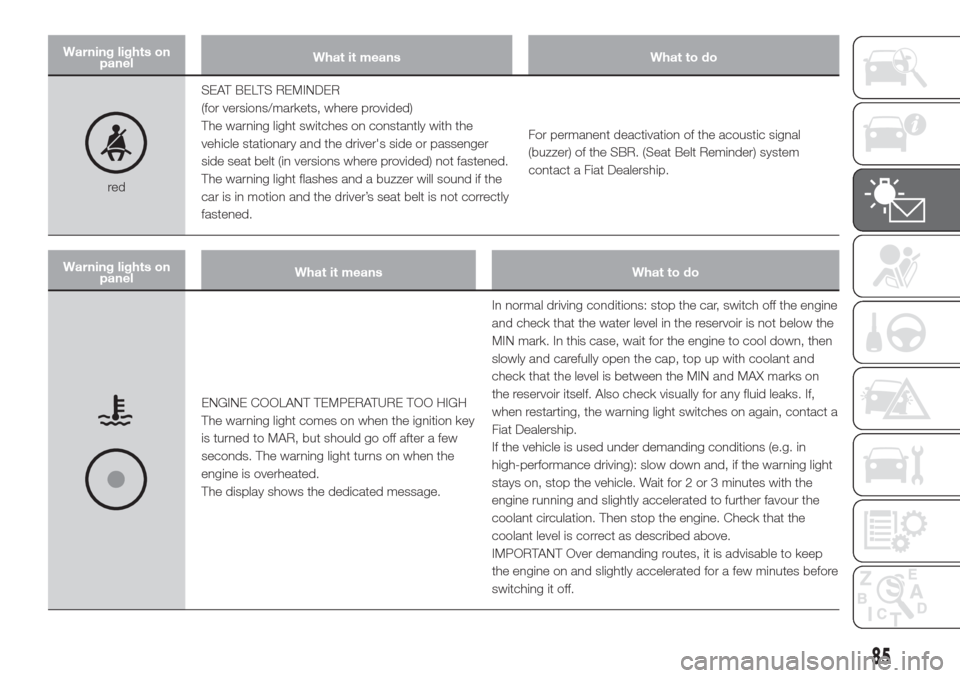
Warning lights on
panelWhat it means What to do
redSEAT BELTS REMINDER
(for versions/markets, where provided)
The warning light switches on constantly with the
vehicle stationary and the driver's side or passenger
side seat belt (in versions where provided) not fastened.
The warning light flashes and a buzzer will sound if the
car is in motion and the driver’s seat belt is not correctly
fastened.For permanent deactivation of the acoustic signal
(buzzer) of the SBR. (Seat Belt Reminder) system
contact a Fiat Dealership.
Warning lights on
panelWhat it means What to do
ENGINE COOLANT TEMPERATURE TOO HIGH
The warning light comes on when the ignition key
is turned to MAR, but should go off after a few
seconds. The warning light turns on when the
engine is overheated.
The display shows the dedicated message.In normal driving conditions: stop the car, switch off the engine
and check that the water level in the reservoir is not below the
MIN mark. In this case, wait for the engine to cool down, then
slowly and carefully open the cap, top up with coolant and
check that the level is between the MIN and MAX marks on
the reservoir itself. Also check visually for any fluid leaks. If,
when restarting, the warning light switches on again, contact a
Fiat Dealership.
If the vehicle is used under demanding conditions (e.g. in
high-performance driving): slow down and, if the warning light
stays on, stop the vehicle. Wait for 2 or 3 minutes with the
engine running and slightly accelerated to further favour the
coolant circulation. Then stop the engine. Check that the
coolant level is correct as described above.
IMPORTANT Over demanding routes, it is advisable to keep
the engine on and slightly accelerated for a few minutes before
switching it off.
85
Page 132 of 300
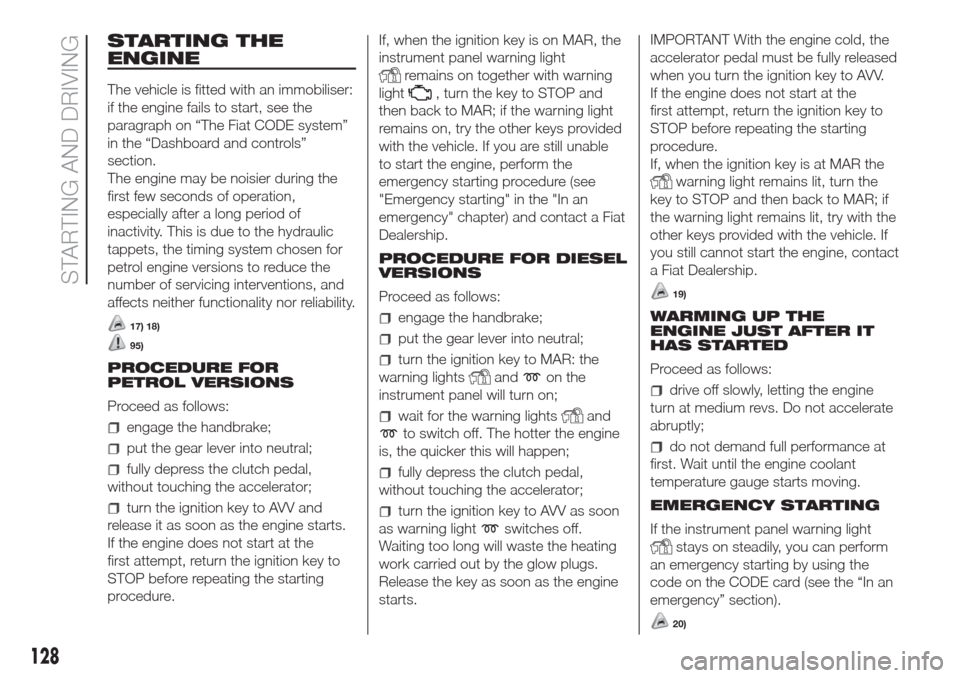
STARTING THE
ENGINE
The vehicle is fitted with an immobiliser:
if the engine fails to start, see the
paragraph on “The Fiat CODE system”
in the “Dashboard and controls”
section.
The engine may be noisier during the
first few seconds of operation,
especially after a long period of
inactivity. This is due to the hydraulic
tappets, the timing system chosen for
petrol engine versions to reduce the
number of servicing interventions, and
affects neither functionality nor reliability.
17) 18)
95)
PROCEDURE FOR
PETROL VERSIONS
Proceed as follows:
engage the handbrake;
put the gear lever into neutral;
fully depress the clutch pedal,
without touching the accelerator;
turn the ignition key to AVV and
release it as soon as the engine starts.
If the engine does not start at the
first attempt, return the ignition key to
STOP before repeating the starting
procedure.If, when the ignition key is on MAR, the
instrument panel warning light
remains on together with warning
light
, turn the key to STOP and
then back to MAR; if the warning light
remains on, try the other keys provided
with the vehicle. If you are still unable
to start the engine, perform the
emergency starting procedure (see
"Emergency starting" in the "In an
emergency" chapter) and contact a Fiat
Dealership.
PROCEDURE FOR DIESEL
VERSIONS
Proceed as follows:
engage the handbrake;
put the gear lever into neutral;
turn the ignition key to MAR: the
warning lights
andon the
instrument panel will turn on;
wait for the warning lightsand
to switch off. The hotter the engine
is, the quicker this will happen;
fully depress the clutch pedal,
without touching the accelerator;
turn the ignition key to AVV as soon
as warning light
switches off.
Waiting too long will waste the heating
work carried out by the glow plugs.
Release the key as soon as the engine
starts.IMPORTANT With the engine cold, the
accelerator pedal must be fully released
when you turn the ignition key to AVV.
If the engine does not start at the
first attempt, return the ignition key to
STOP before repeating the starting
procedure.
If, when the ignition key is at MAR the
warning light remains lit, turn the
key to STOP and then back to MAR; if
the warning light remains lit, try with the
other keys provided with the vehicle. If
you still cannot start the engine, contact
a Fiat Dealership.
19)
WARMING UP THE
ENGINE JUST AFTER IT
HAS STARTED
Proceed as follows:
drive off slowly, letting the engine
turn at medium revs. Do not accelerate
abruptly;
do not demand full performance at
first. Wait until the engine coolant
temperature gauge starts moving.
EMERGENCY STARTING
If the instrument panel warning light
stays on steadily, you can perform
an emergency starting by using the
code on the CODE card (see the “In an
emergency” section).
20)
128
STARTING AND DRIVING
Page 187 of 300
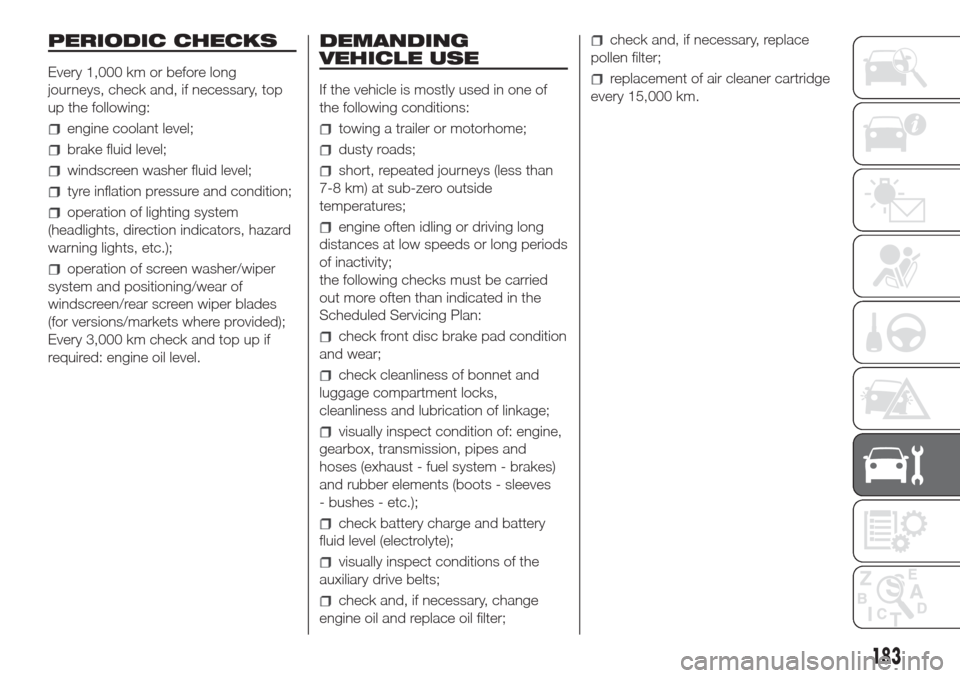
PERIODIC CHECKS
Every 1,000 km or before long
journeys, check and, if necessary, top
up the following:
engine coolant level;
brake fluid level;
windscreen washer fluid level;
tyre inflation pressure and condition;
operation of lighting system
(headlights, direction indicators, hazard
warning lights, etc.);
operation of screen washer/wiper
system and positioning/wear of
windscreen/rear screen wiper blades
(for versions/markets where provided);
Every 3,000 km check and top up if
required: engine oil level.
DEMANDING
VEHICLE USE
If the vehicle is mostly used in one of
the following conditions:
towing a trailer or motorhome;
dusty roads;
short, repeated journeys (less than
7-8 km) at sub-zero outside
temperatures;
engine often idling or driving long
distances at low speeds or long periods
of inactivity;
the following checks must be carried
out more often than indicated in the
Scheduled Servicing Plan:
check front disc brake pad condition
and wear;
check cleanliness of bonnet and
luggage compartment locks,
cleanliness and lubrication of linkage;
visually inspect condition of: engine,
gearbox, transmission, pipes and
hoses (exhaust - fuel system - brakes)
and rubber elements (boots - sleeves
- bushes - etc.);
check battery charge and battery
fluid level (electrolyte);
visually inspect conditions of the
auxiliary drive belts;
check and, if necessary, change
engine oil and replace oil filter;
check and, if necessary, replace
pollen filter;
replacement of air cleaner cartridge
every 15,000 km.
183